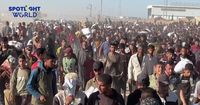On June 26, 2025, Israel ordered a suspension of humanitarian aid deliveries to the northern Gaza Strip, citing concerns that Hamas militants had seized relief supplies from international aid trucks. This move, announced by Israeli Prime Minister Benjamin Netanyahu and defense officials, came after a video surfaced showing armed individuals—whom Israel identified as Hamas fighters—riding on trucks loaded with aid meant for civilians. Despite this, aid deliveries continued as usual in southern Gaza, according to Israeli government spokesman David Mencer.
The suspension has intensified an already fraught humanitarian situation in Gaza, where at least 549 Palestinians have been killed and over 4,000 injured in the past four weeks while attempting to access aid distribution points, according to Gaza government media and the Gaza Humanitarian Foundation (GHF). The GHF, which receives support from both the United States and Israel, plays a central role in distributing aid within Gaza, but its operations have sparked controversy and concern among international observers.
In a significant development, the U.S. government approved $30 million in funding to GHF, marking the first direct financial support from Washington to the organization. This decision was made despite concerns from some U.S. officials about the ongoing violence near aid distribution sites and questions about GHF’s operational practices. Reuters reported that the funding was approved through an "expedited order" from the White House and State Department, with $7 million already disbursed. Sources also suggest that the U.S. may provide an additional $30 million monthly to GHF.
GHF operates in partnership with U.S.-based private military and logistics firms, including Safe Reach Solutions—led by former CIA personnel—and UG Solutions, a security contractor employing U.S. military veterans. These collaborations have raised red flags among humanitarian groups and the United Nations, which have refused to cooperate with GHF. Critics argue that GHF’s close coordination with Israeli military forces and private contractors compromises the neutrality and independence essential to humanitarian aid, potentially turning assistance into a tool for political or military objectives.
Jonathan Whittall, the United Nations’ senior emergency aid official for Palestinian territories, highlighted the dangers faced by Palestinians seeking aid. Speaking on June 22, 2025, Whittall stated that most casualties occurred when individuals were shot or trampled while trying to reach aid points located in militarized zones controlled by Israeli forces. He noted, "When Israeli forces shot at crowds of Palestinians waiting for food along the roads, it resulted in multiple casualties among armed groups." This grim reality underscores the perilous environment surrounding aid delivery in Gaza.
GHF responded to these criticisms on June 24, asserting that it has already distributed 40 million meals within Gaza. A spokesperson for the foundation denied allegations that their aid trucks were looted, stating that their deliveries have been conducted safely. The foundation expressed willingness to collaborate with the United Nations and other humanitarian organizations to expand aid distribution, emphasizing their readiness to "cooperate to help those in need." However, the foundation also temporarily halted aid deliveries earlier in June to demand increased security from Israel for civilians near their distribution points, following several deaths during aid collection.
Meanwhile, the United Nations has described the aid operations in Gaza as dependent on "opportunity," given the ongoing military actions by Israel, restricted access to the territory, and incidents of looting by armed groups. The UN has stressed that looting tends to decrease when consistent aid deliveries reassure the population about the availability of assistance. Yet, the complex interplay of military conflict, political tensions, and humanitarian needs continues to hinder effective relief efforts.
Adding to the complexity, Israel requested that the Trump administration send $500 million to GHF, funds that would come from the U.S. Agency for International Development (USAID) and be integrated into the State Department's budget. Some U.S. officials oppose this support, citing GHF’s lack of experience, the violence near aid distribution points, and its partnerships with private military contractors.
Israel’s suspension of aid to northern Gaza follows the release of footage showing armed individuals on aid trucks, which Israel claims are Hamas militants. Hamas, which has governed Gaza for over two decades, denies these accusations. Despite the suspension in the north, aid deliveries continue in the south, with Israeli officials maintaining that assistance is reaching civilians there.
The humanitarian crisis in Gaza remains dire. Over the past month, Israeli military operations and restrictions have severely limited access to essential supplies. The United Nations only resumed aid deliveries on April 19, 2025, after an 11-week hiatus. Since then, over 400 Palestinians have died while attempting to receive aid from both the UN and GHF, highlighting the deadly risks faced by civilians in the conflict zone.
As the situation unfolds, the international community faces difficult questions about how to provide aid impartially and effectively amid ongoing conflict and political complexities. The tensions between ensuring security, maintaining humanitarian neutrality, and addressing the urgent needs of Gaza’s population continue to challenge all parties involved.




